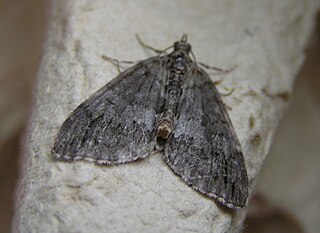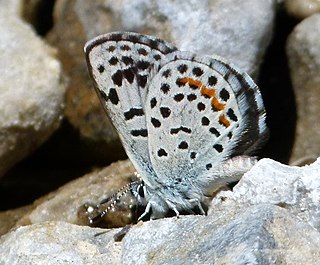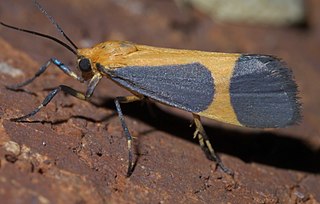
Idia is a genus of litter moths of the family Erebidae first described by Jacob Hübner in 1813.

Renia is a genus of litter moths of the family Erebidae erected by Achille Guenée in 1854.
Dichozoma is a monotypic moth genus of the family Crambidae erected by Eugene G. Munroe in 1961. Its only species, Dichozoma parvipicta, was first described by William Barnes and James Halliday McDunnough in 1918. It is found in North America, where it has been recorded from Arizona, California, Utah and Texas.

Callistege is a genus of moths in the family Erebidae.

Hydriomena is a genus of moths in the family Geometridae described by Jacob Hübner in 1825.

Callistege intercalaris is a moth of the family Erebidae. It is found from Arizona to Texas.
Drasteria hudsonica, the northern arches, is a moth of the family Erebidae. The species was first described by Augustus Radcliffe Grote and Coleman Townsend Robinson in 1865. It is found from Alaska and Yukon to California, east to New Mexico and Manitoba.
Idia julia, or Julia's idia, is a litter moth of the family Erebidae. The species was first described by William Barnes and James Halliday McDunnough in 1918. It is found from southern Canada south to Georgia and Texas.

Calephelis perditalis, also known as the rounded metalmark or lost metalmark, is a species of butterfly in the family Riodinidae. It is found in Texas in the United States and Mexico, south to Venezuela. The species was first described by William Barnes and James Halliday McDunnough in 1918.

Euphilotes ancilla, the Rocky Mountain dotted blue, is a species of butterfly of the family Lycaenidae. It is found from Washington south to California and southern Alberta and Saskatchewan south through the Rockies and high plains to Wyoming, Colorado, Utah, and northwestern New Mexico. The species was first described by William Barnes and James Halliday McDunnough in 1918.
Nasusina mendicata is a moth in the family Geometridae first described by William Barnes and James Halliday McDunnough in 1918. It is found in the US in southern and central California, extending up the coast as far as Sonoma and Napa counties.

Cisthene picta, the pictured lichen moth, is a moth of the family Erebidae. It was described by William Barnes and James Halliday McDunnough in 1918. It is found in the United States from Texas to Arizona. The habitat consists of deserts.
Comadia albistrigata is a moth in the family Cossidae first described by William Barnes and James Halliday McDunnough in 1918. It is found in North America, where it has been recorded from Arizona, New Mexico and Texas.
Cornifrons actualis is a moth in the family Crambidae. It was described by William Barnes and James Halliday McDunnough in 1918. It is found in North America, where it has been recorded from Arizona, California, Montana, Nevada, Texas and Utah. The habitat consists of deserts.
Pyrausta zonalis is a moth in the family Crambidae. It was described by William Barnes and James Halliday McDunnough in 1918. It is found in North America, where it has been recorded from Texas, Arizona and California.
Noctueliopsis palmalis is a moth in the family Crambidae. It was described by William Barnes and James Halliday McDunnough in 1918. It is found in North America, where it has been recorded from California, Nevada and Texas. The habitat consists of high and low elevation deserts.
Noctueliopsis virula is a moth in the family Crambidae. It was described by William Barnes and James Halliday McDunnough in 1918. It is found in North America, where it has been recorded from Arizona, California and Nevada.
Loxostegopsis merrickalis, or Merrick's pyralid moth, is a moth in the family Crambidae. It was described by William Barnes and James Halliday McDunnough in 1918. It is found in North America, where it has been recorded from Alabama, California, Florida, Georgia, Illinois, Indiana, Kansas, Maine, Manitoba, Maryland, Massachusetts, Minnesota, New Hampshire, North Carolina, North Dakota, Ohio, Ontario, Pennsylvania, Quebec, South Carolina, Texas, West Virginia and Wisconsin.

Doryodes tenuistriga is a moth of the family Erebidae first described by William Barnes and James Halliday McDunnough in 1918. It is found in North America, where it has been recorded from costal Texas and Louisiana.
Drasteria pulchra is a moth of the family Erebidae first described by William Barnes and James Halliday McDunnough in 1918. It is found in North America, where it has been recorded from California.








